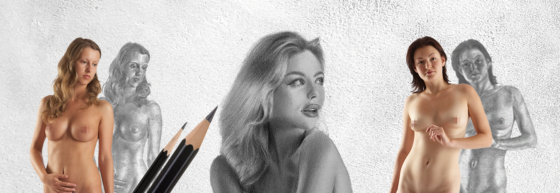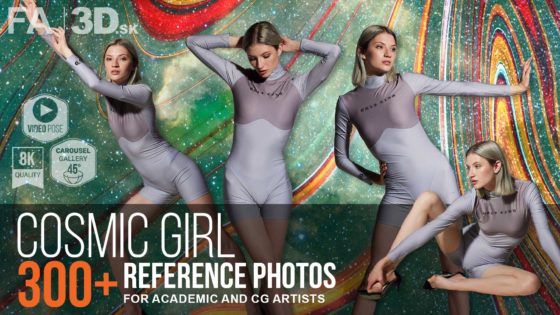
We’re excited to feature Logan Wiesen in our latest blog post, where he breaks down one of the most important yet challenging parts of human anatomy for artists – the mouth. This video tutorial is a must-watch for both 2D and 3D artists aiming to strengthen their understanding and sharpen their skills in capturing realistic facial features. Thank you, Logan, for sharing your knowledge and helping artists level up!
The mouth is a dynamic and complex structure – formed by soft tissues, muscles, fat pads, and subtle bony landmarks. Whether you’re working in 2D or 3D, getting the mouth right is critical to conveying emotion and realism. Small changes in volume, tension, and symmetry can make a major difference in a character’s believability.
The key is not just copying reference, but understanding the forms beneath: orbicularis oris, the fat pads, the dental arch, and how all of those work together to stretch, compress, or relax depending on the expression.
Curvature of the teeth
When drawing, painting, or sculpting the mouth, always consider the form and curvature of the teeth beneath. Even if the teeth aren’t visible, their presence shapes the lips from the inside, much like a framework beneath fabric.
Understanding how the mouth copies the dental arch helps you go beyond surface detail and build a truly structural, believable face.
- The Curve of the Lips Mirrors the Teeth. The upper and lower lips generally wrap around the curved shape of the dental arches—the U-shaped arrangement of the teeth in the skull. This is most evident when the mouth is at rest or slightly open. The upper lip follows the contour of the maxillary (upper) dental arch. The lower lip follows the shape of the mandibular (lower) arch.
- The Curve of the Lips Mirrors the Teeth. The fullness and volume of the lips are also influenced by the placement of the teeth behind them. For example: In a relaxed mouth, the lips sit gently over the teeth, maintaining the curvature of the dental arch. When smiling, the lips stretch over the teeth, revealing more of the dental curve. When frowning or pressing the lips together, the underlying structure pushes against the lips, altering the curvature and shape.
- Asymmetry and Variation. No two dental arches are identical—some are more narrow, others wider, and this uniquely affects each person’s lip shape. Artists should observe how the lip structure responds to the depth and width of the arch underneath.


Downward curve at the corners of the mouth:
The slight downward curve at the corners of the mouth is a natural anatomical feature, shaped by muscle structure, skin tension, and functional design. For artists, it’s a small but powerful detail that adds authenticity, personality, and emotional depth to every face.
- When drawing or sculpting the mouth from the front, don’t place the corners on a straight line – slight downward angling adds realism. In profile views, this downward curve helps guide the flow of the lips as they wrap around the facial structure.
- The corners of the mouth – also known as the oral commissures – are often slightly curved downward at rest, and this natural tilt plays an important role in facial anatomy and expression. While it may seem like a subtle detail, understanding this helps artists add realism, character, and emotional nuance to their work.

🔍 Why the Corners of the Mouth Curve?
Facial Muscle Tension at Rest The mouth is surrounded by the orbicularis oris, a circular muscle that controls lip movement.
At rest, this muscle is relaxed, and gravity pulls the corners of the mouth slightly downward.
Additionally, muscles like the depressor anguli oris attach to the corners and gently pull them down, contributing to this natural resting angle.
This neutral position allows the mouth to easily shift into a wide range of expressions (smiling, frowning, sneering, etc.).
Fat and Skin Distribution The skin and fat pads around the mouth create soft volume, but over time, age or weight changes can emphasize the downward curve.
Area Between the Nose and Lips
The area between the nose and the upper lip is a small but highly expressive and structurally important region of the face. For artists studying anatomy, this space- often overlooked – plays a key role in the realism and character of facial expressions.

🔍 Key Anatomy of the Area Between the Nose and Lips:
- Philtrum (Central Groove) is the vertical groove running from the base of the nose (between the nostrils) to the center of the upper lip.
It forms a soft “M” shape as it flows into the top of the upper lip.
Anatomically, it’s shaped by the depressor septi and orbicularis oris muscles.
Its depth and definition can vary between individuals—some have a deep, pronounced philtrum, while others have a flatter, softer transition. - Cupid’s Bow At the bottom of the philtrum is the Cupid’s bow, the distinct double-curve shape at the center of the upper lip.
The peaks of the bow align with the ends of the philtrum columns and transition into the vermilion border (the edge of the colored part of the lip).
This shape is highly individualized and adds character to a person’s face. - Philtral Columns These are the raised ridges that flank the philtrum, leading up to the base of the nostrils.
They are created by underlying muscle and fat structure, giving the area subtle form and shadow. The columns blend into the nasal base, framing the center of the mouth and giving volume to the middle third of the face. - Nasal Spine & Septum Just above the philtrum is the anterior nasal spine, a bony point at the base of the nose that contributes to the shape of the nasolabial angle.
The nasal septum (the tissue between the nostrils) descends slightly and can cast a shadow that enhances the sculptural quality of the area.
Think of the philtrum area as a valley between two ridges, not just a line.
Light will catch on the philtral columns and Cupid’s bow, while the philtrum groove creates a subtle shadow.
The transition between the nose, philtrum, and lips should feel natural and continuous - avoid hard breaks unless stylizing.
Pay attention to the angle and tilt of the Cupid’s bow and philtrum, as it changes with expression (smiling, tension, etc.).
In stylized or simplified art, a well-placed line or highlight to suggest the philtrum can still add a great deal of realism.The space between the nose and lips – centered around the philtrum – is a small but powerful feature. It holds the rhythm between facial features and adds nuance to expression and identity. Whether you’re sketching, painting, or sculpting, understanding its shape and structure brings an extra level of realism and depth to your portrait work.


Why the Upper Lip Protrudes More
The upper lip typically sits slightly in front of the lower lip due to a combination of skeletal structure, muscle placement, and soft tissue volume. This subtle projection plays a crucial role in the overall harmony and balance of the face, and understanding it is essential for artists aiming to create believable, anatomically correct portraits.

🔍 Key Reasons Why the Upper Lip Protrudes More:
- Skull & Dental Arch Structure. The maxilla (upper jaw) naturally protrudes more than the mandible (lower jaw).
The upper dental arch is slightly more forward and rounded, causing the base of the upper lip to be positioned ahead of the lower lip.
This anatomical relationship helps define the facial profile and varies slightly depending on individual bone structure and ethnic background. - Teeth Position. The upper front teeth (incisors) often have a slight outward tilt and sit in front of the lower front teeth in a natural overbite.
Because the upper lip covers these teeth, it follows their projection and tends to bulge forward more than the lower lip. - Soft Tissue Volume. The upper lip has a more complex and layered structure: it includes the philtrum, Cupid’s bow, and greater soft tissue definition around the nasal base.
The shape is also influenced by the orbicularis oris muscle, which wraps around the mouth and contributes to lip tension and volume. - Functional Design. From a functional standpoint, the upper lip acts as a protective covering for the more exposed upper teeth and contributes more prominently to facial expressions like smiling or speaking.
This forward placement enhances articulation and visibility of the mouth during speech and emotional expression.
From the lower lip to the chin
The transition from the lower lip to the chin is a subtle but crucial area in facial anatomy that greatly affects the realism and expressiveness of a portrait or sculpt. Here’s a breakdown for artists looking to understand and render this area accurately:
- The Labiomental Groove. This is the small depression or fold just below the lower lip.
It creates a natural break in the surface between the lower lip and the chin.
Its depth and definition vary with age, gender, and facial expressions. - Fat Pads and Soft Tissue. Between the lower lip and chin, there’s a fat pad that gives volume and softness.
This area should appear smooth but not flat—there’s a gentle convex transition as you move from the lip down into the chin. - The Mentalis Muscle. This muscle lies just over the chin and contributes to expressions like pouting or chin dimpling.
It also helps push the lower lip upward and can cause small vertical wrinkles in older individuals or during tension.


Always observe from reference – real faces, sculptures, or high-quality 3D scans. Each face is unique, and this transition zone can vary widely in form and expression. Study how this area behaves under different lighting and angles for the most believable results.
Enhance Your 3D Character Art Journey Incorporating these simple yet effective anatomical guides into your sculpting process can vastly improve the life-like quality of your character models. Logan’s approach teaches us that understanding anatomy through simple shapes can be an accessible method for artists at any skill level.
Explore Mouth Anatomy with 3D model
Dive into the details of human mouth anatomy with our 3D scan of Bashra’s mouth from 3D.sk! For the best study experience, view it in full screen to catch every intricate detail. It’s a fantastic resource for anyone looking to enhance their understanding of mouth structures.
Join us in celebrating the fusion of artistic talent and anatomical accuracy with Logan Wiesen!
As a professional artist, I’m consistently impressed by the extensive range and quality of human anatomy references at 3D.sk.
Logan Wiesen

Check out also Logan Wiesen’s fantastic works on his Instagram or website and support him by like and follow.
Join our community & Get inspired by TOP artists:
Explore DRAWINGS by Artists of the day





















